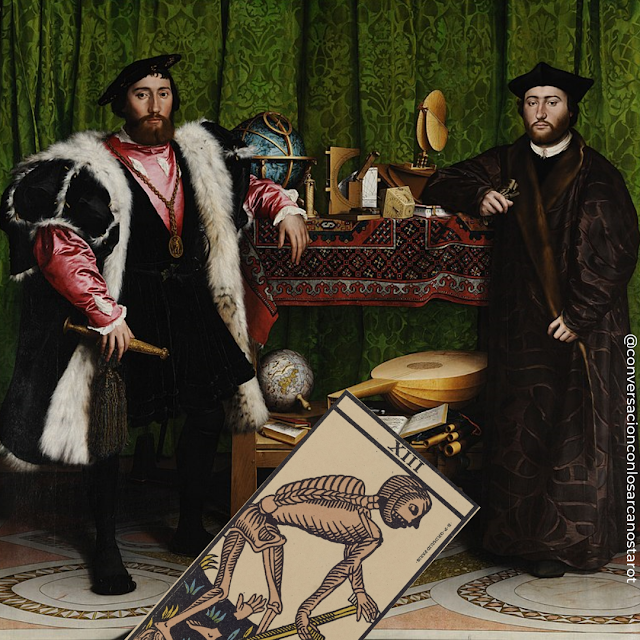Holbein retrata a la perfección y con todo lujo de detalles los
objetos que vemos entre ambos personajes: en la estantería superior vemos el
globo celeste, el reloj de sol poliédrico y varios instrumentos para comprender
los cielos y medir el tiempo. En la estantería inferior vemos un laúd, un globo
terrestre un libro de aritmética y un libro de salmos; sus ropajes, así como la
perspectiva del suelo que recuerda el mosaico de Westminster Abbey; también es
muy precisa la decoración de la alfombra turca.
Lo más sorprendente de la obra es la anamorphosis o
deformación de la perspectiva (invento del renacimiento) de una calavera que
vemos en primerísimo plano en el suelo entre ambos personajes y que solamente
reconocemos si cambiamos el punto de vista, ubicándonos a la derecha para
observar el cuadro tangencialmente.
The
Ambassadors by Holbein and Arcane XIII
This work by Hans Holbein the Younger made in 1533
that we can admire in the National Gallery in London portrays two young French
ambassadors, Jean de Dinteville and Georges de Selve who are in the Tudor era
of England just like the artist of German origin who spent much of his life in
this country.
Holbein portrays perfectly and with detail the objects
that we see between the two characters: on the top shelf we see the celestial
globe, the polyhedral sundial, and various instruments to understand the heavens
and measure time. On the lower shelf, we see a lute, a globe, an arithmetic
book, and a book of psalms; their clothes, as well as the perspective of the
floor recalls the mosaic of Westminster Abbey; The decoration of the
Turkish carpet is also very precise.
The most surprising thing about the work is the
anamorphosis or perspective distortion (a Renaissance invention) of a skull
that we see in close-up on the ground between the two characters and that we
only recognize if we change the point of view, placing ourselves on the right
to observe the canvas tangentially.
This Arcana that the Marseille Tarot does not name and
that Holbein in his great double portrait mentions beyond using a simple trick
of perspective indicates how very close we are to death in our daily lives, in
fact, the personal motto of Dinteville was “remember you will die”.





No hay comentarios:
Publicar un comentario